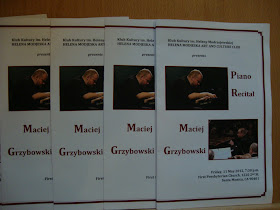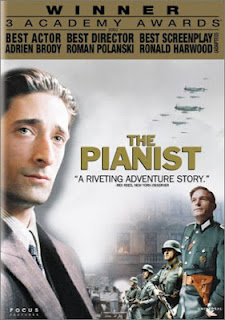Time for Christmas, again...and time to remember "Lulajze, Jezuniu" - the beloved Christmas lullaby that Chopin quoted in his first Scherzo, Op. 20 in B Minor, while staying in Vienna after leaving Poland forever in 1830. The drama of the November uprising and the distance from his beloved family, coupled with anxiety and a foreboding of no return, put the young composer in an emotional turmoil, expressed most poignantly in his famous Stuttgart Diaries.
Like the private journal entries, the Scherzo provides an outlet for outpouring of emotion and is permeated with flights of desperation. The sweet lullaby provides a moment of serenity in the midst of this emotional onslaught. It is a symbol of tranquility of home and familial love that, as Chopin felt in 1830, may have been lost forever...
- Chopin's Scherzo in B Minor by Garrick Ohlsson (9'33'', Warsaw, Poland)
- Chopin's Scherzo in B Minor by Krzysztof Jablonski (1985, 8'45'' - the lullaby is at 3'20'')
- Chopin's Scherzo in B Minor by Sviatoslav Richter (10'30'', with an ad at the beginning)
- Chopin's Scherzo in B Minor by Artur Rubinstein (8'46'', from 1949, note the variety of tempi throughout!)
- Lulajze Jezuniu (Hush, Baby Jesus) by Polish State Folk Song and Dance Ensemble Mazowsze (version uploaded from an LP)
- Lulajze Jezuniu by Jazz Vocalist Urszula Dudziak with her daughter
- Lulajze Jezuniu by Anna Maria Jopek
Lulajże, Jezuniu
1. Lulajże, Jezuniu, moja perełko,
Lulaj, ulubione me pieścidełko.
Ref. Lulajże, Jezuniu, lulajże, lulaj!
A ty Go, Matulu, w płaczu utulaj.
2. Zamknijże znużone płaczem powieczki,
Utulże zemdlone łkaniem usteczki.
Ref. Lulajże, Jezuniu, lulajże, lulaj!
A ty Go, Matulu, w płaczu utulaj.
3. Lulajże, piękniuchny nasz Aniołeczku,
Lulajże, wdzięczniuchny świata Kwiateczku.
Ref. Lulajże, Jezuniu, lulajże, lulaj!
A ty Go, Matulu, w płaczu utulaj.
Hush, Little Jesus
Hush, Baby Jesus, my little pearl
Hush, my beloved sweet-pea doll
Hush, Little Jesus, hush, do not cry
And you, dear Mommy, comfort him now
Close your tiny eyelids tired of crying
Close your little mouth faint of sobbing
Hush, Little Jesus, hush, do not cry
And you, dear Mommy, comfort him now
Hush, our beautiful cherub so sweet
Hush, our graceful bloom of the world
Hush, Little Jesus, hush, do not cry
And you, dear Mommy, comfort him now
(trans. Maja Trochimczyk)
And you, dear Mommy, comfort him now
Hush, our beautiful cherub so sweet
Hush, our graceful bloom of the world
Hush, Little Jesus, hush, do not cry
And you, dear Mommy, comfort him now
(trans. Maja Trochimczyk)
Poles around the world celebrate the beloved holiday starting on Christmas Eve, with a formal "Wigilia" dinner, that though sumptuous and featuring 12 different dishes, like the 12 apostles, is supposedly a "fasting" meal, without meat or meat products. When the first star is seen on the horizon, families sit down to a dinner with one empty place setting left for Divine Presence, or an uninvited guest who might show up on the doorstep on this most holy of nights.
 The dinner on a white tablecloth covering a bit of hay, starts with sharing best wishes for the next year, breaking a white rectangular wafer called "oplatek" and with the Christmas carol, "Wsrod nocnej ciszy..." (In the Silence of the Night). The dishes include pickled herring, pumpernickel, kapusta wigilijna (sourkraut stewed with dried mushrooms, prunes, and raisins), various mushroom and fish dishes, beet soup with mushroom-stuffed pierogi and "uszka" (mini-pasta), a variety of gingerbread, shortbread, and poppy-seed desserts, and "kompot wigilijny" (a compote made with several kinds of dried fruit).
The dinner on a white tablecloth covering a bit of hay, starts with sharing best wishes for the next year, breaking a white rectangular wafer called "oplatek" and with the Christmas carol, "Wsrod nocnej ciszy..." (In the Silence of the Night). The dishes include pickled herring, pumpernickel, kapusta wigilijna (sourkraut stewed with dried mushrooms, prunes, and raisins), various mushroom and fish dishes, beet soup with mushroom-stuffed pierogi and "uszka" (mini-pasta), a variety of gingerbread, shortbread, and poppy-seed desserts, and "kompot wigilijny" (a compote made with several kinds of dried fruit). The Polish Christmas carols provide a unique soundtrack to this celebration and having these carols along with early Polish music provides an unforgettable atmosphere at the Wigilia table. "Lulajze, Jezuniu" (Hush, little Jesus), though dating back to the 17th century, is not the oldest Polish carol. It belongs among a genre especially popular in Poland, that of tranquil Christmas lullabies, that include also "Gdy sliczna Panna" (When the Lovely Virgin), "Jezus Malusienki" (The Tiny Baby Jesus), "Mizerna cicha stajenka licha" (The Poor, Still, Humble barn), and "Oj Maluski" (Oh, the Tiny One), the latter one in the "gorale" dialect of the foothills of Tatra Mountains.
- Gdy sliczna Panna (When the Lovely Virgin) by Natalia Kukulska
- Jezus Malusienki (The Tiny Baby Jesus) by the Cugowski brothers (Krzysztof, Wojciech, Piotr) - Polish rock musicians
- Oj Maluski (Oh, the Tiny One) by Anna Maria Jopek
- Oj, Maluski (Oh, the Tiny One) by Maryla Rodowicz (in weird Country-Western style)
In Poland, Christmas-themed songs are divided into koledy (carols) and pastoralki (shepherd's songs), the latter with humorous or sentimental texts bringing the Nativity home to poor shepherds of Polish villages. The word "koleda" comes from the Latin Calendae, the "first day of the month".
"W Zlobie Lezy" (He Lies in a Manger), dating back to the fifteenth century, is one of the earliest Polonaises. Its text is attributed to the Polish Jesuit and famous patriotic preacher, Piotr Skarga, while the melody resembles the coronation polonaise of King Wladyslaw IV Waza. The most famous of Polish carols - Polonaises is the magnificent "Bog Sie Rodzi" (God is Born), with text by Franciszek Karpinski dating back to 1792 and the melody reputedly used for the coronation of Polish kings back in the 16th century. These two Polonaises and "Lulajze Jezuniu," as well as many other Polish carols are in a lilting triple meter that suffuses Polish folklore with its characteristic flowing and graceful rhythm.
"W Zlobie Lezy" (He Lies in a Manger), dating back to the fifteenth century, is one of the earliest Polonaises. Its text is attributed to the Polish Jesuit and famous patriotic preacher, Piotr Skarga, while the melody resembles the coronation polonaise of King Wladyslaw IV Waza. The most famous of Polish carols - Polonaises is the magnificent "Bog Sie Rodzi" (God is Born), with text by Franciszek Karpinski dating back to 1792 and the melody reputedly used for the coronation of Polish kings back in the 16th century. These two Polonaises and "Lulajze Jezuniu," as well as many other Polish carols are in a lilting triple meter that suffuses Polish folklore with its characteristic flowing and graceful rhythm.
- W Zlobie Lezy (He Lies in a Manger) by Polish State Folk Song and Dance Ensemble Mazowsze
- Bog Sie Rodzi (God is Born) by Polish State Folk Song and Dance Ensemble Mazowsze
Not all the carols are in triple meter, of course. Here's a stately "march" about the angel and the shepherds:
- Aniol Pasterzom Mowil (Angel Talked to the Shepherds) by Polish State Folk Song and Dance Ensemble Mazowsze
 The officially approved religious carols were gathered in a variety of Church Songbooks, for instance in the early 19th-century songbook "Śpiewnik kościelny" (Church Hymnbook, 1838-53) edited by Michał Marcin Mioduszewski. The very first recorded Polish Christmas carol was "Zdrow bądź, krolu anjelski" (Hail, the Angelic King) from the 14th century.
The officially approved religious carols were gathered in a variety of Church Songbooks, for instance in the early 19th-century songbook "Śpiewnik kościelny" (Church Hymnbook, 1838-53) edited by Michał Marcin Mioduszewski. The very first recorded Polish Christmas carol was "Zdrow bądź, krolu anjelski" (Hail, the Angelic King) from the 14th century.- Zdrow badz, krolu anjelski (Hail the Angelic King) by Chamber Choir of the Wieniawski Music Society, Lublin 2007.
Other earliest koledy were based on Latin melodies with texts adapted into Polish. "Chwalmyż wszyscy z weselem" (Let Us All Praise with Joy) and "Pieśń o narodzeniu Pańskim" (Song about the Lord's Birth) were both based on the melody of the Latin "Dies est laetitiae." The Polish carol "Ojca niebieskiego" (Of Heavenly Father's) used a melody known in the whole Europe. "Dzieciątko dostojne z błogosławionej Dziewice Maryjej" (The Honourable Child From Blessed Virgin Mary) was based on Latin carol "Salve parvule." "Narodził się nam dziś niebieski" (Today, the Heavenly Lord was born unto us) was a version of medieval "Angelus Domini ad pastores." "To-ć czas wdzięczny przyszedł" (A Graceful Time Has Come) was a variant of the Latin hymn of praise of angels, "Ave hierarchia."
- Chwalmyz wszyscy z weselem (Let Us All Praise with Joy) by Choir Amici Canentes, 2009
- Dies est Laetitia from Neresheimer Organ Tabulatur, 16th century.
We should not forget the "Melodie na Psałterz Polski" (Melodies to Polish Psalter), a pearl of Polish Renaissance music by the Protestant Mikołaj Gomółka (1535 - 1591?), though these lovely pieces are not carols at all... A very popular evening prayer by Waclaw of Szamotuly, "Juz sie zmierzcha" (Already it is Dusk) inspired Henryk Mikolaj Gorecki (1933-2010) to write his first String Quartet, extensively quoting from the tranquil Renaissance melody.
- "Juz Sie Zmierzcha" (Already it is Dusk) by Boys Choir Poznanskie Slowiki (studio recording)
- "Juz Sie Zmierzcha" (Already it is Dusk) by Boys Choir Polskie Slowiki (Paris concert)
- Cicha Noc (Silent Night) by Poznanskie Slowiki
- Cicha Noc (Silent Night) by Polish State Folk Song and Dance Ensemble Slask (solo with chorus and orchestra)
- Cicha Noc (Silent Night) by Krzysztof Krawczyk
There are many more Polish carol settings by classical composers, and multiple versions of carols by popular musicians, including even such giants of Polish jazz as Urszula Dudziak, or of Polish rock as Slawomir Krajewski (who wrote several carols to texts by Agnieszka Osiecka that became classics in their own right).
Merry Christmas, everyone!
___________________________
SOURCES OF INFORMATION:
I'm quoting the titles of the earliest Polish carols from an outstanding website Completorium Polish Early Music Collection, created by Boguslaw Krawczyk and featuring Polish earliest Christmas Carols. This site is included in the Kunst der Fuge international site on Medieval and Renaissance Music.
More in-depth studies and comments on Polish music may be found on the blog of Prof. Adrian Thomas,
For a study of "Religious Folklore in Chopin's Music" by Jan Wecowski, including the incipit of the "Lulajze Jezuniu" carol copied above, see the article in the Polish Music Journal of 1999.
Academic studies of Polish carols include: Polskie kolędy i pastorałki by Anna Szweykowska (Krakow: PWM Edition, 1985), in Polish, out of print.
Photos and stories from family albums of Maja Trochimczyk
























